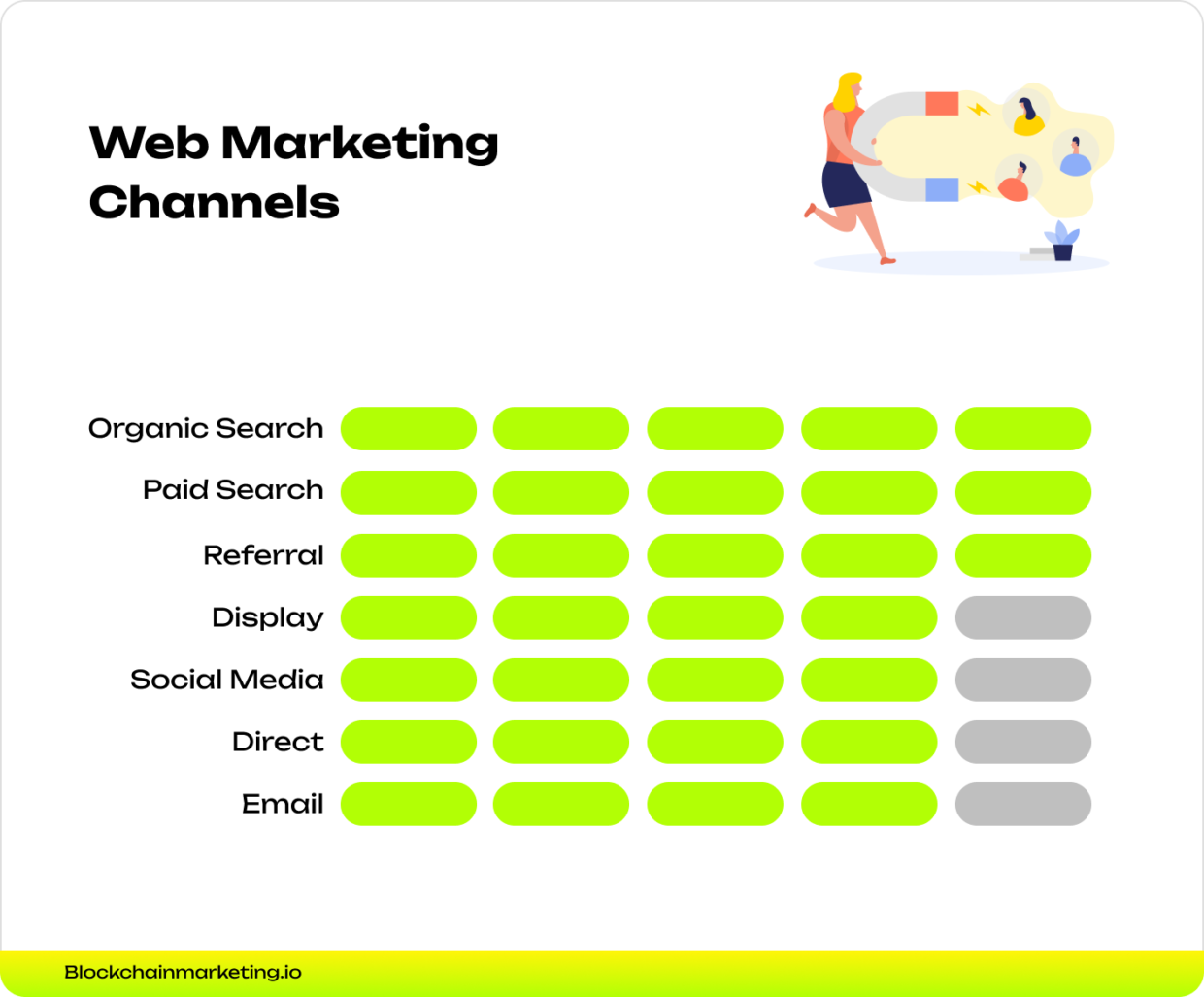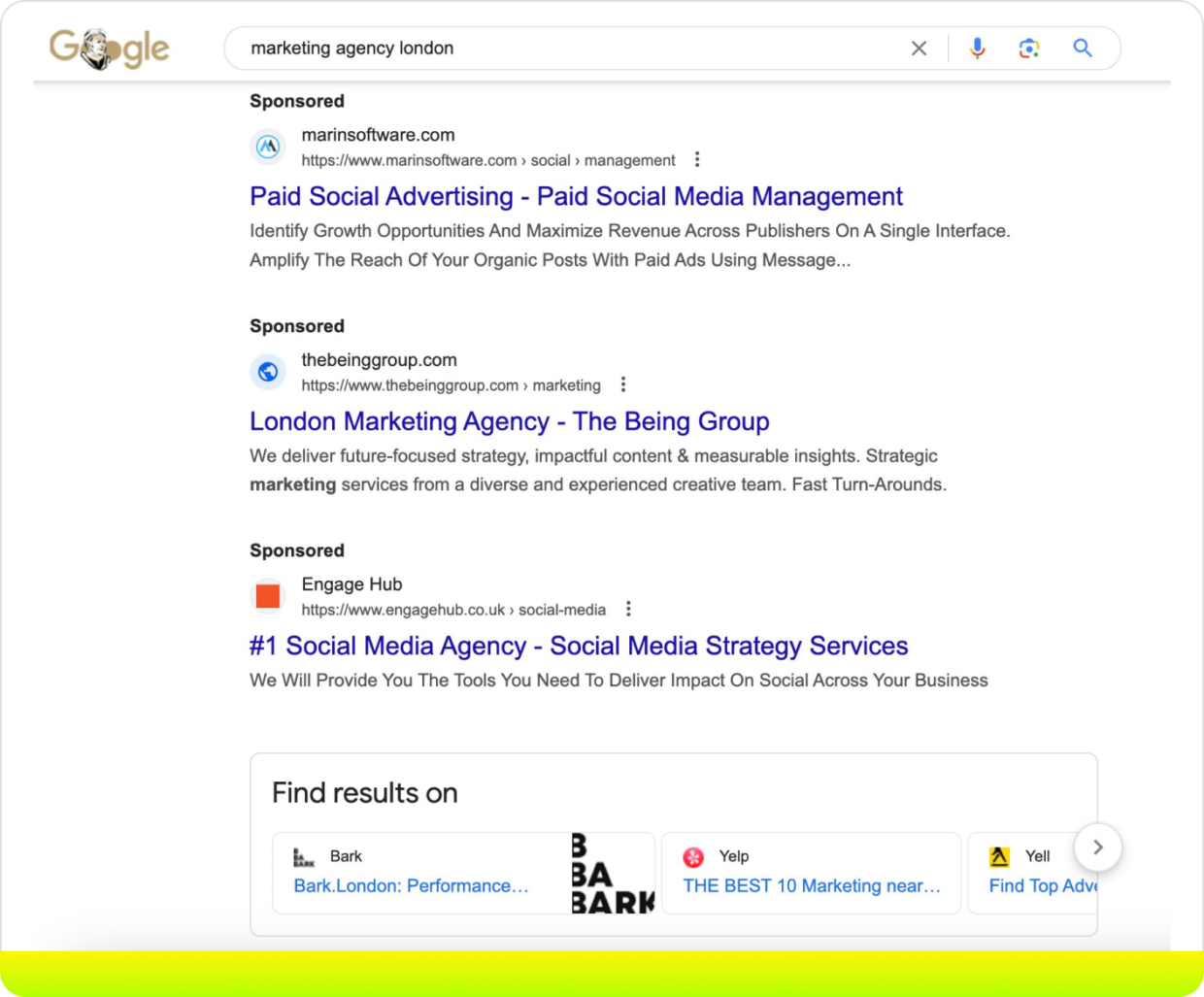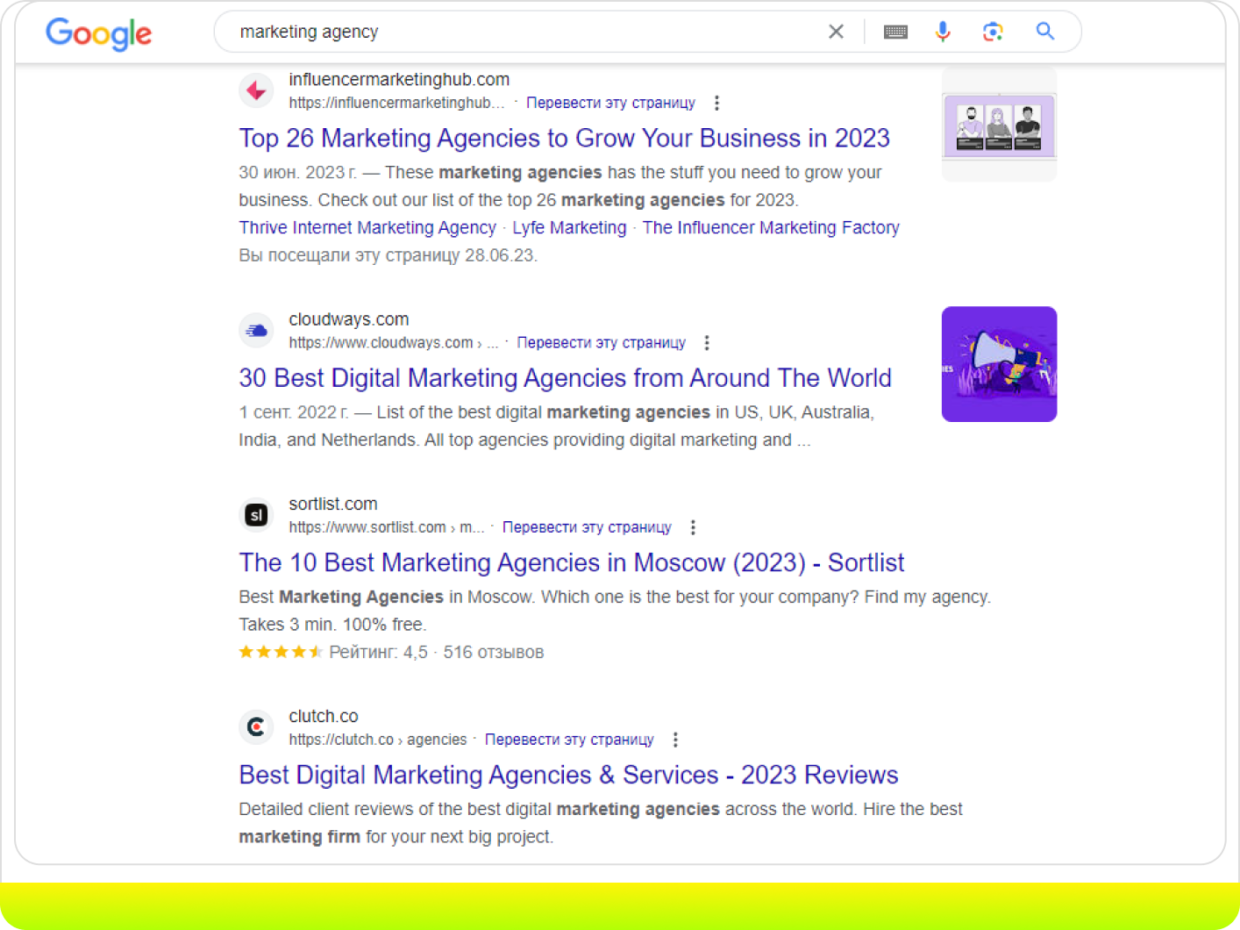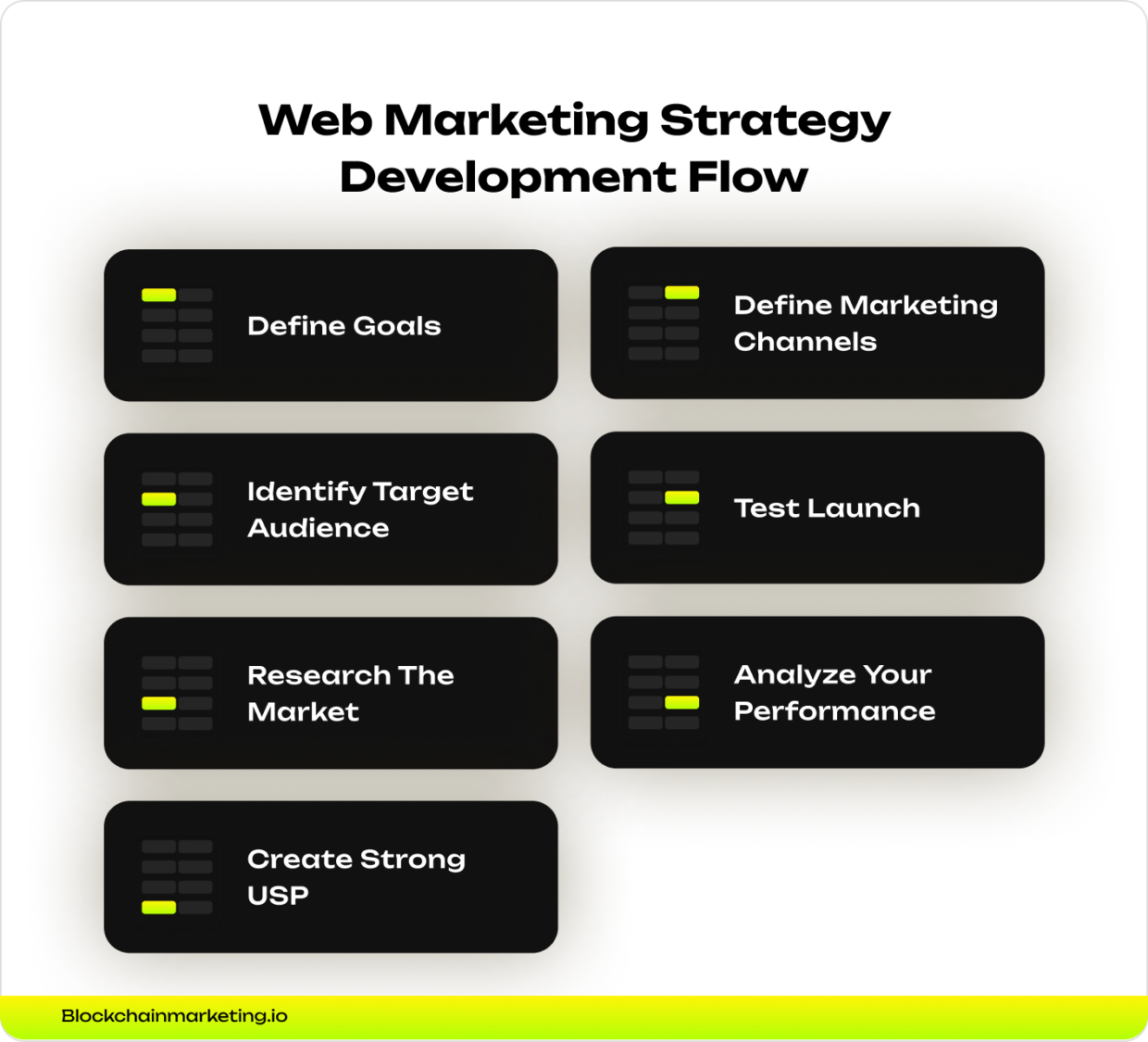Web Marketing Guide: What is it and How it Works?
July 18, 2023
299 views
Medium

What is Web Marketing?
Web marketing refers to the marketing of products and services online. It involves various methods and practices for customer acquisition, sales, and outreach in the most cost-effective way for business.
Web marketing structure includes several marketing channels, which allow businesses to generate traffic online and lead users to their websites.
In this article, we’ll describe how web marketing works and how you can boost your results with the right approach to marketing online.
Web Marketing Channels
There are 7 main marketing channels you should know about before making any attempts in web marketing. Here is the shortlist.
- Paid Search
- Display
- Organic Search
- Direct
- Referral
- Social Media
Let’s find out what these channels are and how they work.

Paid Search
Paid search is a web marketing channel that refers to paid advertising in search engines like Google, Bing, Yahoo, Baidu, etc. Simply put, you’re paying to display your ads at the top of the search results for particular keywords.
The working principle is relatively simple. Let’s see how it works in an example.
Imagine that you’re a UK-based marketing agency and would like to acquire new customers using paid search ads in Google. First, you must do keyword research and gather a semantic core. Since you’re a UK-based marketing agency, search terms such as “marketing agency in UK” or “marketing agency London” will be useful for you, and you would like to be displayed at the top of search results by these keywords.
To make keyword research more effortless, you can use Google Keyword Planner Tool, SemRush or Ahrefs.
When you gather the list of relevant keywords, you can create search ads and launch your campaign. In general, your ads will look like in the screenshot below.

Of course, the campaign setup process is much more complicated and requires a comprehensive data-driven approach to ad creation, keyword research, and demographics targeting setup. The flow described above needs to be more detailed and was used to show how paid search actually works.
Paid search is one of the vital web marketing channels. However, it has its own pros and cons. Let’s take a closer look.
Pros of Paid Search
- Detailed targeting options
- Detailed performance analytics
- Immediate results
- Traffic increase
Cons of Paid Search
- It’s expensive
- It requires constant monitoring of campaign performance
Display
Display web marketing channel refers to paid advertising on websites. Simply, it is banner or video ads you see all over the internet. You’ll usually use the same platforms to set up search and display campaigns, as Google Ads and Microsoft Ads provide search and display advertising formats.
However, you can also launch display ads using other programmatic platforms like Criteo or Adroll.
There are four types of Display ads, which are based on targeting specifications.
Remarketing – focuses on users who have already visited your website or exist in your customer base.
Contextual – based on contextual targeting options like keywords, website themes, etc.
Demographic – based on customer’s demographic parameters and interests
Site-placed – uses certain websites as a targeting option for ad display.
Pros of Display Ads
- Increases exposure
- Can be viral
- Detailed performance analytics
- Traffic increase
- Immediate results
Cons of Display Ads
- Ad blockers
- Low conversion rate
- Banner blindness
- It’s expensive
Organic Search
Organic search relates to Search Engine Optimization (SEO) – website optimization aimed at traffic acquisition and improving your website’s position in organic search. Although you don’t pay directly to be displayed in search results like in paid search, SEO also requires significant investments.
Website optimization can be divided into two categories: On-Page and Off-Page.
On-Page optimization focuses on site content improvements to rank higher in search results. Here is a short list of key points of On-Page optimization.
- Metatags optimization
- Images optimization
- Content production
- Internal linking
- Structure optimization
- Using SEO-friendly URLs
Off-Page optimization, on the other hand, implies optimization activities outside the website. These activities include the following:
- Link building
- Guest posting
- Social media
- Listings
- Reviews
Direct
Direct is a web marketing channel that indicates users who visit your website directly. It means they entered your URL or added a website to your favorites.
To increase direct traffic, you must raise your exposure and brand recognition. This can be achieved with PR activities and Display advertising targeted at a broad audience.
Referral
A referral channel means your website users come to you from other websites. This is one of the most performing tools for conversion rate in B2B and B2C segments.
Most commonly, referral traffic sources look like ranks and listings. Web pages like “Top 10 Marketing Agencies in the UK” are well-indexed and can easily reach the top of search results. Listing in such articles may bring you significant impact and drive sales.

Social Media
Social media can also drive traffic, leads, and sales to your project. There are several options to promote your business on social media platforms like Facebook, Instagram, Twitter, LinkedIn and others.
First, you can utilize paid promotion – each social media has its own internal advertising platform, and you can launch banner and video campaigns promoting your products and services.
Secondly, you can promote your business organically – building your own community and creating engaging content may also attract the attention of potential customers and increase the number of leads.
To find out which option suits you best, it is worth making a test launch of a marketing campaign and checking how both options perform for you.
When it comes to emails as a web marketing channel, the definition is not required. Email as a source means visits from emails. Unlike other channels focused on acquiring new users, email most often operates with the existing customer base.
This is a perfect solution to increase the number of sales, remind you about your brand, and grow and educate your potential clients.
No doubt, sending personalized emails is a must for any project making attempts at web marketing. Let’s find out how email marketing flow works:
Step 1 – Audience segmentation. Divide your database by segments and make personalized mailing blasts.
Step 2 – Building email marketing strategy. Build an email marketing strategy that will help you communicate efficiently with both clients and employees.
Step 3 – Creating mailing chains and automation. Automate your emails so you can focus on more pressing business goals.
Step 4 – Setting up analytics. Keep tabs on how well your email blasts are doing and adjust your strategy as needed.
How to Create a Web Marketing Strategy?
Okay, now it’s clear what web marketing is and what are the main channels, let’s figure out how to create an effective web marketing strategy:

Define your goals
When it comes to creating a web marketing strategy, the first step you need to apply is to define your goals and objectives. Estimate the approximate results you are keen to achieve and set your goals correctly.
Remember that your goals have to be clear and realistic. To make sure that you’re moving in the right direction, you can use such methods as SMART or OKR. These principles will help you to create transparent and achievable goals, so each member of the team will have an imagination of what you’re striving to reach.
Identify your target audience
Create a portrait of your ideal customers and discover their problems and how you can solve them. Your objective as a web marketer is to offer and deliver the best solution to your potential customers. Hence you need to understand what they need and how to propose your products and services.
To have a better understanding of who your potential clients are, answer the following questions:
- Who is your perfect customer?
- What does your perfect customer want?
- What customer problems can you solve?
- How can you attract new customers?
Do market research
Explore your competitors and their offerings. Research how they’re doing marketing, what channels they use, and try to find gaps in their marketing strategy. Moreover, this will let you make a better proposition for your potential audience. Since you have background information about your competitors, you have a competitive advantage, and you can beat their offer, which will make yours more valuable for potential clients.
Create strong USP
USP stands for Uniques Selling Proposition – it’s a unique benefit you can offer to your clients, which stands you out from other offerings. To create a strong USP, you have to complete both previous points cause your offers have to be based on data. Keep in mind the following tips to make an effective selling proposition:
USP must be specific. Your offer has to be simple, clear and transparent. Potential clients need to understand what you offer and what problems it will solve.
USP must be unique. You have to offer something new. If your competitors already have the same offer, your proposal will not work the best.
USP must be valuable. Make an accent on the value for your potential clients. Briefly highlight your benefits and how you can solve the problems.
Define marketing channels
No doubt, it’s better to utilize all marketing channels in your marketing strategy. However, you need to figure out some key directions and make a focus on several channels.
This approach will let you save your marketing budget and focus on the most valuable channels for your business.
Test launch
Make a test launch of your marketing campaigns and see how it goes. Create a media plan and allocate the marketing budget among several channels. Some channels take more time to test; for example, SEO requires 3-6 months to see the first results. So, set a specific time frame, and remember to set up marketing analytics.
Performance audit
After the test launch, it’s necessary to make a performance audit. Analyzing how channels work for you and what results you manage to achieve will let you see the whole picture of your marketing activities.
Some channels work better, and others just waste your budget – analytics will help you to figure out the gaps in your strategy and adjust your investments to the most cost-effective channels.
Web Marketing and Web Design
Since web marketing suggests online activities, in most cases, you’ll acquire new customers through your website. That’s why you need to create a website according to the latest web design practices.
Comprehensive web design will improve your conversion rate and increase users’ engagement. Hence, you need to focus on UI/UX improvements and create an advanced, modern, and convenient website before taking any web marketing actions.
Here are some of the best web design practices that have emerged and gained prominence in 2023:
1. Mobile-First Design: With the increasing use of smartphones and tablets, designing for mobile devices has become crucial. Mobile-first design involves creating websites with mobile devices in mind from the start. This approach prioritizes responsive and adaptive design, ensuring a seamless user experience across different screen sizes.
2. Minimalistic and Clean Layouts: Minimalism remains a popular trend in web design, focusing on simplicity, clarity, and ample white space. Clean layouts help users focus on the essential content and create a visually appealing and uncluttered browsing experience. Designers are using bold typography, striking visuals, and strategic placement of elements to create impactful and engaging websites.
3. Dark Mode: Dark mode has gained significant popularity in recent years, and it continues to be a prevalent web design practice in 2023. Dark backgrounds with light text not only provide a visually appealing aesthetic but also reduce eye strain and improve readability in low-light environments.
4. Microinteractions: Microinteractions are subtle animations or effects that provide feedback and enhance the user experience. These can include hover effects, button animations, scrolling transitions, or loading indicators. By adding micro-interactions, web designers can make websites feel more dynamic, engaging, and interactive.
5. Voice User Interface (VUI) Design: As voice assistants and smart speakers become more integrated into our daily lives, designing for voice interaction is gaining importance. VUI design involves creating intuitive voice interfaces that allow users to navigate and interact with websites using voice commands. Designers are focusing on creating conversational interfaces and optimizing content for voice search.
6. Accessibility: Web accessibility continues to be a critical consideration in web design. Designers are incorporating accessibility features to ensure that websites are usable by people with disabilities. This includes providing alternative text for images, using proper heading structures, ensuring color contrast, and implementing keyboard navigation.
7. Performance Optimization: Website speed and performance are vital for user satisfaction and search engine rankings. In 2023, web designers are prioritizing performance optimization techniques, such as optimizing image and code size, minimizing HTTP requests, and leveraging caching and content delivery networks (CDNs). By focusing on performance, websites can deliver faster loading times and a smoother user experience.
8. Personalization and Dynamic Content: Tailoring website experiences to individual users has become increasingly important. By utilizing user data and personalization algorithms, web designers can deliver personalized content, recommendations, and user interfaces. Dynamic content, such as real-time updates and personalized notifications, creates a more engaging and relevant browsing experience.
9. Security and Privacy: With growing concerns about online security and privacy, web designers are placing more emphasis on safeguarding user data. Secure protocols (HTTPS), data encryption, and privacy-oriented design practices are crucial considerations. Clear and transparent privacy policies and cookie consent mechanisms are also important for building trust with users.
10. Sustainability and Green Design: As environmental awareness increases, sustainable web design practices have gained traction. Designers are optimizing code, reducing file sizes, and utilizing energy-efficient hosting options. They are also incorporating eco-friendly design elements and promoting environmentally conscious behaviors through their websites.
These are some of the best web design practices that have emerged and gained prominence in 2023. By staying up-to-date with the latest trends and technologies, web designers can create modern, user-friendly, and engaging websites that meet the needs of today’s digital landscape.
The Bottom Line
We live in a digital world, and web marketing is a must for most businesses nowadays. It implies various methods, techniques, channels, and instruments, and if you would like to become a professional in these fields, it’s necessary to get a deeper knowledge of how each channel works and how it can improve your marketing strategy. Nevertheless, this guide can give you a general imagination of web marketing and how it can help your business.
Subscribe to our newsletter
We send out weekly newsletter with the best marketing tips.




